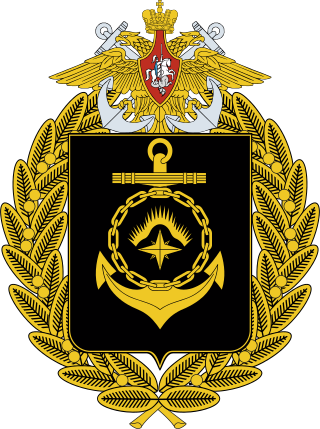
The Oscar class, Soviet designations Project 949 Granit and Project 949A Antey, are a series of nuclear-powered cruise missile submarines designed in the Soviet Union for the Soviet Navy. First built in the 1970s, six remain in service with the Russian Navy. Two other vessels were slated to be modernized since at least 2017 as Project 949AM, to extend their service life and increase combat capabilities but it is unclear whether work continues as of 2023.

USS Baton Rouge (SSN-689) was a Los Angeles-class nuclear-powered attack submarine which served with the United States Navy. With her keel laid down on 18 November 1972, Baton Rouge was launched on 26 April 1975. She became the second Los Angeles-class submarine to be commissioned, on 25 June 1977. In 1995, she was the first of her class to be decommissioned, after a collision with a Russian Sierra-class submarine.
K-27 was the only nuclear submarine of the Soviet Navy's Project 645. It was constructed by placing a pair of experimental VT-1 nuclear reactors that used a liquid-metal coolant into the modified hull of a Project 627A (November-class) vessel. A unique NATO reporting name was not assigned.

The Victor class, Soviet designations Project 671 Yorsh, Project 671RT Syomga and Project 671RTM/RTMK Shchuka,, are series of nuclear-powered attack submarines built in the Soviet Union and operated by the Soviet Navy. Since the 1960s, 48 units were built in total, of which the last remaining are currently in service with the Russian Navy. The Victor-class submarines featured a teardrop shape, allowing them to travel at high speed. These vessels were primarily designed to protect Soviet surface fleets and to attack American ballistic missile submarines. Project 671 began in 1959 with the design task assigned to SKB-143.

K-407 Novomoskovsk is a Project 667BDRM Delfin-class ballistic missile submarine of the Russian Navy's Northern Fleet.

The Akula class, Soviet designation Project 971 Shchuka-B is a series of fourth generation nuclear-powered attack submarines (SSNs) first deployed by the Soviet Navy in 1986. There are four sub-classes or flights of Shchuka-B, consisting of the original seven Project 971 boats, commissioned between 1984 and 1990; six Project 971Is, commissioned between 1991 and 2009; one Project 971U, commissioned in 1995; and one Project 971M, commissioned in 2001. The Russians call all of the submarines Shchuka-B, regardless of modifications.

The Northern Fleet is the fleet of the Russian Navy in the Arctic.
The K-442 Chelyabinsk is an Oscar II Class SSGN of the Russian Navy.

The Sierra class, Soviet designations Project 945 Barrakuda and Project 945A Kondor,, are a series of nuclear-powered attack submarines intended for the Soviet Navy and currently in service with the Russian Navy.
B-414 Daniil Moskovsky was a Project 671RTM Schuka attack submarine of the Russian Northern Fleet. The submarine was laid down in 1989, launched and commissioned in 1990. It was known as K-414 before renaming in 1992. In 1994 B-414 took part in joint combat service with SSBN Karelia (K-18) of the Delta IV class. In 1996 the submarine was named after Prince Daniil Moskovsky, the youngest son of Alexander Nevsky.

The submarine incident off Kildin Island was a collision between the US Navy nuclear submarine USS Baton Rouge and the Russian Navy nuclear submarine B-276 Kostroma near the Russian naval base of Severomorsk on 11 February 1992. The incident occurred while the US unit was engaged in a covert mission, apparently aimed at intercepting Russian military communications. Although most sources claim that the American submarine was trailing her Russian counterpart, some authors believe that neither Kostroma nor Baton Rouge had been able to locate each other before the collision.

K-114 Tula is a Project 667BDRM Delfin-class nuclear-powered ballistic missile submarine (SSBN). As such, she carries a complement of R-29RM Shtil and R-29RMU Sineva nuclear submarine-launched ballistic missiles (SLBM) as her primary deterrent mission, along with anti-ship missiles and torpedoes, the latter for self-defense. Built in Severodvinsk during the late 1980s, she served with the Soviet Navy before being transferred to the Russian Navy following the dissolution of the Soviet Union. Tula underwent an extensive overhaul during 2000–2004 and was fitted with upgraded Shtil SLBMs, several of which were launched from her during her later operational life. She was sponsored by the city of Tula, and is homeported in Gadzhiyevo.

K-266 Orel is a Project 949AM nuclear-powered cruise missile submarine (SSGN). She is one of three Oscar II submarines still serving in the Russian Northern Fleet, all assigned to the 11th Submarine Division, berthed at Guba Bolshaya Lopatka, on the Kola Peninsula northwest of Severomorsk.

The submarine Incident off Kola Peninsula was a collision between the US Navy nuclear attack submarine USS Grayling and the Russian Navy nuclear ballistic missile submarine K-407 Novomoskovsk some 150 km (90 mi) north of the Russian naval base of Severomorsk, on 20 March 1993. The incident took place when the American submarine, who was trailing her Russian counterpart, lost track of Novomoskovsk. At the time that Grayling reacquired the other submarine, the short distance of only half-mile made the collision unavoidable. The incident happened just a week before the first summit between American president Bill Clinton and the president of the Russian Federation, Boris Yeltsin.
The K-119 Voronezh is an Oscar-class submarine in the Russian Navy.

The K-410 Smolensk is an Oscar-class submarine in the Russian Navy.
The K-132 Irkutsk is an Oscar-class submarine in the Russian Navy.

The K-317 Pantera is an Akula-class submarine in the Russian Navy.
The K-391 Bratsk is an Akula-class submarine in the Russian Navy.
The K-461 Volk (En:Wolf) is an Akula-class submarine of the Russian Navy.












